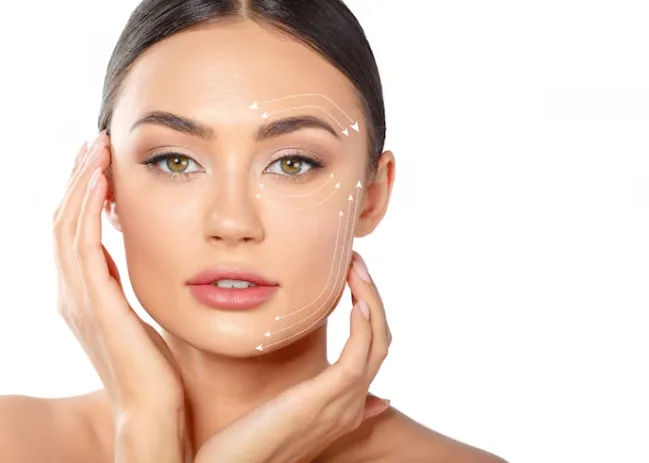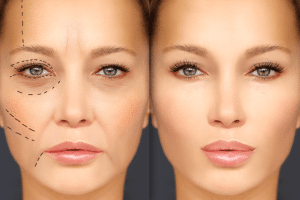Cosmetic face surgery encompasses a variety of procedures tailored to enhance facial aesthetics and improve self-confidence. Among these, Rhinoplasty, or nose reshaping, and Blepharoplasty, targeting the eyelids, are highly sought for their ability to harmonize facial features and rejuvenate the eyes, respectively.
What is cosmetic Face Surgery?
Face surgeries refer to a collection of surgical procedures performed on the face to address concerns related to aging, asymmetry, and overall facial appearance. These procedures aim to enhance facial features, restore youthfulness, and improve self-confidence. Cosmetic Face surgery can target specific areas or provide a comprehensive makeover, depending on individual needs and goals.
Facelift surgery, also known as rhytidectomy, is a popular cosmetic procedure to rejuvenate the face and reduce visible signs of aging. It is designed to address sagging skin, deep wrinkles, and loss of facial volume, resulting in a more youthful and refreshed appearance.
Common Types of Cosmetic Face Surgery
- Rhinoplasty (Nose Surgery): Tailored to reshape or resize the nose, rhinoplasty is one of the most common facial surgeries. It can correct a wide range of concerns, from aesthetic proportions to breathing issues caused by structural defects.
- Facelift (Rhytidectomy): Aimed at reducing signs of aging, a facelift tightens facial skin, removes excess fat, and repositions soft tissues, offering a more youthful appearance. It often focuses on the lower half of the face and the neck.
- Blepharoplasty (Eyelid Surgery): This surgery corrects droopy eyelids by removing excess skin, fat, and muscle from the upper and lower eyelids, helping to improve vision and offer a more rested and alert appearance.
- Forehead Lift (Brow Lift): Targeting the brow and forehead area, this procedure elevates drooping eyebrows and reduces wrinkles and lines on the forehead, creating a smoother, more youthful brow line.
Different Types of Face Surgery
Cosmetic Face surgery, also known as facial plastic surgery, encompasses a range of procedures designed to enhance and rejuvenate various areas of the face. Whether you’re looking to reverse signs of aging or reshape specific features, face surgery offers numerous options to achieve your desired aesthetic goals.
This article will explore what Cosmetic face surgery entails and the different types and kinds of face surgery available, including face, cheek, neck, brow, forehead, temple, and facial contouring. Let’s dive into the details.
Clinic contact number: +989371200167
FaceLift
A facelift, or rhytidectomy, is a popular Cosmetic face surgery that addresses sagging skin, deep wrinkles, and facial laxity. It involves the removal of excess skin and tightening underlying tissues to restore a more youthful and rejuvenated appearance. Depending on the desired outcome, facelifts can target the midface, lower face, or both. The procedure typically requires incisions along the hairline and around the ears to access the underlying tissues.
Cheek Lift
A cheek lift, or midface lift, focuses on lifting and tightening the cheeks to enhance facial contours and correct sagging or hollowed cheeks. This procedure rejuvenates the midface area, resulting in a more defined cheekbone structure and a youthful appearance. Cheek lifts are commonly performed through incisions within the hairline or inside the mouth to access and lift the underlying tissues.
Neck Lift
A neck lift, or lower rhytidectomy, targets sagging skin, excess fat deposits, and muscle banding in the neck area. This procedure removes or repositions the excess skin and tightens the underlying muscles to create a smoother, more toned neck contour. Neck lifts often involve incisions around the ears and beneath the chin to effectively access and address the neck tissues.
Brow Lift
A brow lift, also called a forehead lift, aims to address sagging brows, forehead lines, and drooping eyebrows. By repositioning the brow and smoothing forehead wrinkles, a brow lift can create a more refreshed and alert appearance. Brow lifts may be performed using different techniques, including the traditional method with an incision across the hairline or endoscopic techniques with smaller incisions and the use of specialized instruments.
Forehead Lift
A forehead lift specifically targets the upper portion of the face, addressing forehead wrinkles, frown lines, and drooping eyebrows. It involves repositioning the brow and tightening the forehead muscles to achieve a smoother and more youthful forehead. Forehead lifts are typically performed using either the traditional open method or the minimally invasive endoscopic approach, depending on the individual’s needs.

Temple Lift
A temple lift, sometimes performed with a brow or facelift, focuses on addressing the hollowed or sagging areas in the temple region. This procedure rejuvenates the temples, restoring volume and improving overall facial harmony. Temple lifts often use small incisions within the hairline to access and lift the tissues in the temple area.
Facial Contouring
Facial contouring refers to a range of cosmetic procedures designed to reshape and enhance the structural aspects of the face, aiming to create a more balanced and aesthetically pleasing appearance. This can involve both surgical and non-surgical methods, each targeting different areas of the face to achieve the desired outcome. The primary goal is to alter the contours of the face, enhancing or minimizing specific features according to the individual’s preferences and the natural harmony of their facial structure.
Facial contouring surgery, also known as facial sculpting or facial reshaping, is a cosmetic procedure aimed at enhancing the facial structure and achieving a more balanced, harmonious appearance. This surgical technique involves altering certain facial features’ shape, size, or position to create a more aesthetically pleasing look.
Facial contouring surgery can address various concerns, such as a weak chin, disproportionate facial proportions, or signs of aging. By improving the overall balance and symmetry of the face, this procedure can boost self-confidence and improve the patient’s quality of life.
Surgical Facial Contouring
Surgical options include rhinoplasty (nose reshaping), chin augmentation or reduction, cheek augmentation, and jawline reshaping. These procedures can significantly alter one’s appearance by modifying the underlying bone structure or adding implants to enhance certain features. Surgical contouring is often considered by those seeking permanent changes and can address concerns ranging from asymmetry to disproportions in the face.
Non-Surgical Facial Contouring
Non-surgical methods have gained popularity due to their less invasive nature and shorter recovery times. Techniques such as filler injections (hyaluronic acid, for example), Botox for jawline reshaping, and fat dissolving injections for double chin reduction offer temporary but impactful enhancements. These treatments can sculpt the facial profile by adding volume to areas like the cheeks and lips or reducing volume in the jawline, providing a more defined and contoured look.
Facial contouring is highly personalized, requiring a skilled practitioner to assess the unique features of each individual’s face and determine the most suitable approach to achieve natural-looking results. It’s essential for anyone considering these procedures to consult with a qualified cosmetic surgeon or dermatologist to discuss their goals, understand the potential risks and benefits, and ensure that the chosen treatments align with their overall aesthetic vision and health.
Clinic contact number: +989371200167
Cutting Edge Techniques in Cosmetic Face Surgery
Cosmetic face surgery, a specialized branch of plastic surgery, has witnessed significant advancements and innovations, driven by research and practice in leading institutions and by prominent figures in the field. Universities such as Harvard Medical School and Johns Hopkins University have been at the forefront, contributing extensively to both the theoretical and practical aspects of cosmetic facial procedures.
Esteemed professionals, such as Dr. Rod J. Rohrich from the Dallas Plastic Surgery Institute and Dr. Julie Park from the University of Chicago, have made substantial contributions through their research, clinical practices, and educational endeavors. These experts have not only advanced the techniques in facial rejuvenation, rhinoplasty, and facial reconstruction but also have paved the way for the next generation of surgeons through rigorous training programs.
In terms of clinical application and innovation, The Mayo Clinic stands out as one of the most active and recognized institutions in the realm of cosmetic face surgery. Offering a wide range of procedures from minimally invasive techniques such as botox and fillers to more complex surgeries like facelifts and rhinoplasties, The Mayo Clinic is renowned for its cutting-edge treatments and patient care.
Recent statistics highlight a growing trend in the demand for cosmetic face surgery, with the American Society of Plastic Surgeons reporting over 1.8 million cosmetic surgical procedures performed in the United States in the last year alone. Among these, rhinoplasty, eyelid surgery, and facelifts rank as the most popular, underscoring an increased societal acceptance and desire for aesthetic enhancements.
This surge is complemented by advancements in surgical techniques and safety measures, including the use of 3D imaging and minimally invasive endoscopic methods, which have significantly improved outcomes and reduced recovery times for patients.

Side Effects of Cosmetic Face Surgeries
While face surgeries can provide transformative results, being aware of potential side effects is important. Here are some commonly observed side effects associated with various face surgeries:
- Swelling and Bruising: Swelling and bruising are common side effects following Cosmetic face surgery. They typically subside within a few weeks but can vary depending on the extent of the procedure.
- Pain and Discomfort: Some degree of pain and discomfort is expected after Cosmetic face surgery. Your surgeon will provide pain management strategies to help alleviate discomfort during recovery.
- Scarring: Incisions made during face surgeries result in scars. Skilled surgeons aim to minimize visible scarring by placing incisions strategically and using advanced techniques. Over time, scars generally fade and become less noticeable.
- Numbness or Altered Sensation: Temporary numbness or altered sensation in the surgical area is common and usually resolves gradually over time. However, in rare cases, some individuals may experience persistent changes in sensation.
Because cosmetic surgery can bring lasting and dramatic changes to your outside appearance, it is important to understand how these changes might affect you on the inside. Mayo Clinic
Summary
Cosmetic face surgery offers a comprehensive suite of procedures designed to enhance and rejuvenate the facial appearance, each targeting specific areas and concerns to achieve a harmonious and youthful look. Blepharoplasty, or eyelid surgery, and Rhytidectomy, known as facelifts, are classic procedures that address aging signs around the eyes and lower face, respectively, by removing excess skin and tightening the remaining tissue.
Similarly, a Brow Lift can elevate a drooping forehead and brow area, significantly improving the overall expression and making it appear more alert and youthful. These procedures, when combined with Facial Contouring, which involves bone reshaping to refine the facial structure, can dramatically transform one’s appearance, enhancing symmetry and balance.
Additionally, a Neck Lift, or Platysmaplasty, complements facial surgeries by addressing the laxity and banding in the neck area, providing a smoother, more defined neck and jawline that is often desired for a complete rejuvenation. Fat Transfer, another key technique in cosmetic face surgery, utilizes the patient’s own fat to add volume to areas like the cheeks, lips, and under-eye hollows, offering natural-looking results and improving facial contours.
Together, these procedures provide a holistic approach to facial rejuvenation, allowing individuals to achieve their aesthetic goals with tailored solutions. The ability to combine techniques like these not only enhances the overall aesthetic but also ensures that results are cohesive, maintaining the unique features that define individual beauty.
Clinic contact number: +989371200167
FAQs
1. What is the typical recovery period after Cosmetic face surgery? The recovery period varies depending on the specific procedure. Generally, patients can expect a few weeks of swelling, bruising, and discomfort. Following your surgeon’s post-operative instructions is crucial for optimal healing.
2. Are face surgery results permanent? While face surgery can provide long-lasting results, it’s important to note that the natural aging process continues.
3. What are the most common types of cosmetic face surgeries?
Common cosmetic face surgeries include rhinoplasty (nose reshaping), blepharoplasty (eyelid surgery), facelift (rhytidectomy), brow lift (forehead lift), cheek augmentation, and chin augmentation (genioplasty). Each procedure targets different areas of the face to achieve specific aesthetic goals.
4. What should I expect during the consultation for cosmetic face surgery?
During the consultation, the plastic surgeon will assess your facial features, discuss your goals and expectations, and review your medical history to determine your candidacy for surgery. They may also explain the procedure in detail, discuss potential risks and complications, and provide information about the recovery process.
5. How long is the recovery period for cosmetic face surgery?
The recovery period varies depending on the type and extent of the procedure. In general, patients can expect some swelling, bruising, and discomfort immediately following surgery. Recovery times can range from a few days for minimally invasive procedures like injectables to several weeks for more extensive surgeries like facelifts.
https://www.mayoclinic.org/tests-procedures/cosmetic-surgery/about/pac-20385138



